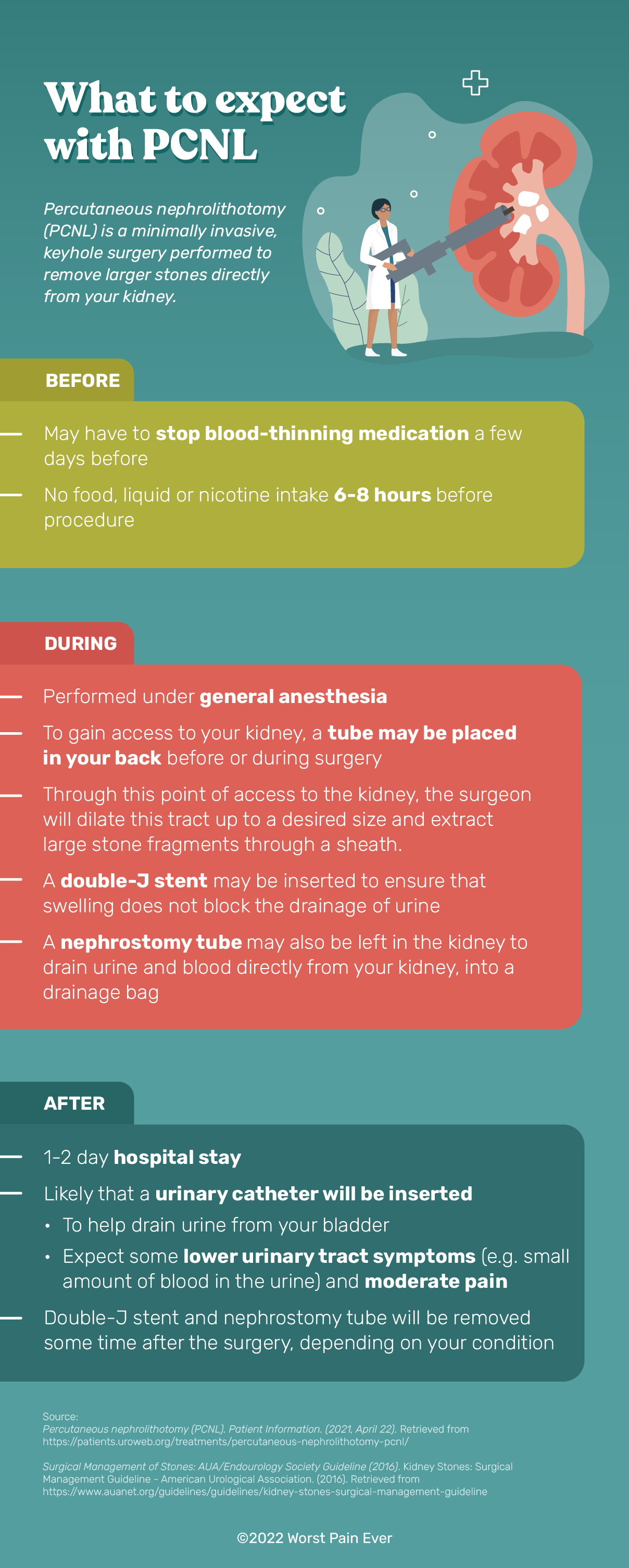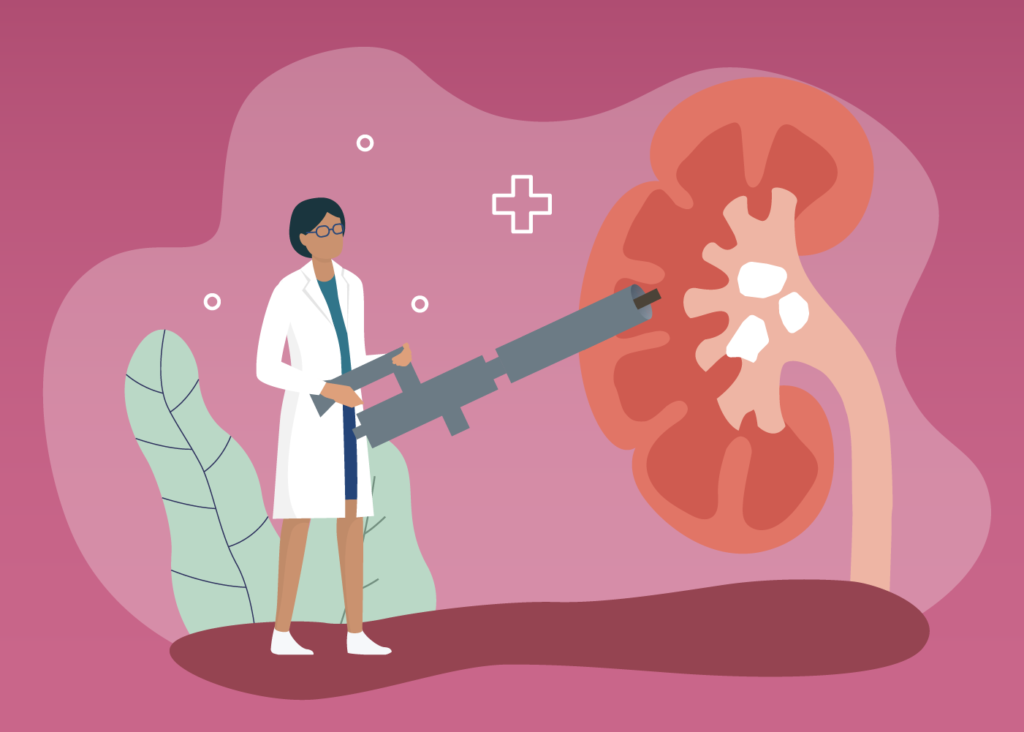Percutaneous nephrolithotomy (PCNL) is a long, scary-sounding name for a kidney stone procedure, but don’t be intimidated! Despite being slightly more invasive than other procedures for kidney stones, it is one of the best options for stones that are too difficult to reach or too large for shock wave lithotripsy or ureteroscopy1. Here’s a handy guide on what to expect and how you can prepare for it.
What is PCNL?
PCNL is a kidney stone removal procedure that involves making a small incision in your back or flank area. A nephroscope (a small camera device) will then be inserted through the hole to locate the stone.
Depending on your stone size, there are two methods your urologist may use to remove the stone: they will either remove it with a basket-like device or use a laser to break it up. These fragments will then be removed.
This procedure requires general anesthesia, and you may be required to stay in the hospital for one or two days. A small price to pay for finally being stone-free!
Who is it best suited for?
PCNL is best for patients with stones that are too large, too difficult to reach, or unable to be treated with extracorporeal shock wave lithotripsy (ESWL) or ureteroscopy (URS). They’re also suitable for patients with infections2.
How should I prepare for my PCNL surgery?
Tell your urologist if you’re taking any anticoagulants (blood-thinning medication) such as Warfarin. You may need to stop taking it a few days before your procedure. You will also need to empty your bladder and take some pain medication, so listen out for your urologist’s instructions!
As you will be under general anesthesia during the procedure, you should not eat, drink or smoke at least 6–8 hours before the procedure1. As anesthesia can make you woozy for a little while after, remember to also arrange for a ride home, or have a family member or friend accompany you home safely.
What happens during the procedure?
The surgery can take up to 3–4 hours3.
You will first be placed under general anesthesia. Once you’re asleep, a small tube (called a catheter) will be placed in your bladder to drain the urine. This will act as a guide for another catheter to be inserted.
Through the second catheter, a substance called “contrast” will be infused into the kidneys, which will help to make your stones more visible during imaging. This allows your urologist to know the exact location of your stone. At the same time, X-rays and ultrasounds will be used to visualize your urinary tract.
A thin needle will be inserted into the collecting system of your kidney. This point of access will then be carefully dilated so that it is big enough for a thin, tube-like instrument (called a nephroscope) to access the kidney1.
Another basket-like instrument will be used to extract smaller stones. Bigger stones will need to be fragmented by a laser before they can be removed.
Once all your stones are removed, another round of contrast will be used to ensure that there are no more stones left. After that, a double-J stent will be inserted to ensure that any swelling will not block the drainage of urine.
Voila! The procedure is complete and you’re now stone-free!
For a clearer visualization of how PCNL is performed, click here to watch a helpful video by the European Association of Urology.
How should I take care of myself after treatment?
Since you will be placed under general anesthesia, you may have to stay in the hospital for 1—2 days after the procedure4.
The walls of your ureter may be swollen after the procedure and making peeing difficult. Tubes such as a double-J stent, nephrostomy tube, or catheter may be left in to help drain your urine and leftover blood from the procedure1,5.
These will usually be removed the day after the surgery, or when the bleeding has lessened significantly⁵. However, do look out for any abnormal bleeding such as thick clumps of blood4, as well as any signs of infection such as fever or chills4. Contact your urologist immediately if this happens.
Avoid strenuous exercise or heavy lifting for at least a week after surgery⁵. You should be able to return to work/your daily routine once you’ve had sufficient rest!
You can expect to have a follow-up with your urologist 4—6 weeks after your surgery. You will likely have an X-ray or ultrasound taken to make sure there are no more stones left and that you’re healing well⁵.
We know it’s a lot to remember! But don’t fret – simply save the image below on your phone for easy reference whenever you need!

Sources:
- Percutaneous Nephrolithotomy (PCNL). EAU Patient Information. Retrieved 15 September 2022, from https://www.uofmhealth.org/conditions-treatments/adult-urology/kidney-stones#:~:text=Ureteroscopy%20with%20laser%20lithotripsy%20(URS,surgeon%20to%20see%20the%20stone
- Percutaneous Nephrolithotomy / Nephrolithotripsy. National Kidney Foundation. Retrieved 15 September 2022, from https://www.kidney.org/atoz/content/kidneystones_PNN#will-i-be-hospitalized-procedure
- Percutaneous Nephrolithonomy (PCNL). John Hopkins Medicine. Retrieved 15 September 2022, from https://www.hopkinsmedicine.org/health/treatment-tests-and-therapies/percutaneous-nephrolithonomy-pcnl
- Percutaneous nephrolithotomy. Mayo Clinic. Retrieved 15 September 2022, from https://www.mayoclinic.org/tests-procedures/percutaneous-nephrolithotomy/about/
- Percutaneous Nephrolithotomy. University of Michigan Health. Retrieved 15 September 2022, from https://www.uofmhealth.org/conditions-treatments/adult-urology/percutaneous-nephrolithotomy





